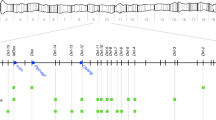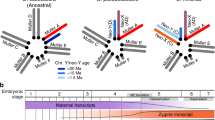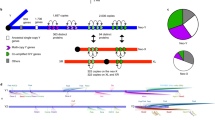Abstract
Meiotic drivers are a class of selfish genetic elements whose existence is frequently hidden due to concomitant suppressor systems. Accordingly, we know little of their evolutionary breadth and molecular mechanisms. Here, we trace the evolution of the Dox meiotic drive system in Drosophila simulans, which affects male–female balance (sex ratio). Dox emerged via stepwise mobilization and acquisition of multiple D. melanogaster gene segments including from protamine, which mediates compaction of sperm chromatin. Moreover, we reveal novel Dox homologs and massive amplification of Dox superfamily genes on X chromosomes of its closest sisters D. mauritiana and D. sechellia. Emergence of Dox loci is tightly associated with 359-class satellite repeats that flank de novo genomic copies. In concert, we find coordinated diversification of autosomal hairpin RNA-class siRNA loci that target subsets of Dox superfamily genes. Overall, we reveal fierce genetic arms races between meiotic drive factors and siRNA suppressors associated with recent speciation.
This is a preview of subscription content, access via your institution
Access options
Access Nature and 54 other Nature Portfolio journals
Get Nature+, our best-value online-access subscription
$29.99 / 30 days
cancel any time
Subscribe to this journal
Receive 12 digital issues and online access to articles
$119.00 per year
only $9.92 per issue
Buy this article
- Purchase on Springer Link
- Instant access to full article PDF
Prices may be subject to local taxes which are calculated during checkout






Similar content being viewed by others
Data availability
Paired-end RNA-seq reads from Dmau, Dsim and Dsech testis, and small RNA data from Dmau and Dsech are available from the GEO database: GSE185361.
Code availability
Codes for analyses in this manuscript are available at https://github.com/Lai-Lab-Sloan-Kettering/Dox_evolution.
References
Zanders, S. E. & Unckless, R. L. Fertility costs of meiotic drivers. Curr. Biol. 29, R512–R520 (2019).
Agren, J. A. & Clark, A. G. Selfish genetic elements. PLoS Genet. 14, e1007700 (2018).
Lindholm, A. K. et al. The ecology and evolutionary dynamics of meiotic drive. Trends Ecol. Evol. 31, 315–326 (2016).
Jaenike, J. Sex chromosome meiotic drive. Annu Rev. Ecol. Syst. 32, 25–49 (2001).
Helleu, Q. et al. Rapid evolution of a Y-chromosome heterochromatin protein underlies sex chromosome meiotic drive. Proc. Natl Acad. Sci. USA 113, 4110–4115 (2016).
Tao, Y., Hartl, D. L. & Laurie, C. C. Sex-ratio segregation distortion associated with reproductive isolation in Drosophila. Proc. Natl Acad. Sci. USA 98, 13183–13188 (2001).
Tao, Y. et al. A sex-ratio meiotic drive system in Drosophila simulans. II: an X-linked distorter. PLoS Biol. 5, e293 (2007).
Tao, Y., Masly, J. P., Araripe, L., Ke, Y. & Hartl, D. L. A sex-ratio meiotic drive system in Drosophila simulans. I: an autosomal suppressor. PLoS Biol. 5, e292 (2007).
Garrigan, D. et al. Genome sequencing reveals complex speciation in the Drosophila simulans clade. Genome Res 22, 1499–1511 (2012).
Masly, J. P. & Presgraves, D. C. High-resolution genome-wide dissection of the two rules of speciation in Drosophila. PLoS Biol. 5, e243 (2007).
Presgraves, D. C., Gerard, P. R., Cherukuri, A. & Lyttle, T. W. Large-scale selective sweep among segregation distorter chromosomes in African populations of Drosophila melanogaster. PLoS Genet. 5, e1000463 (2009).
Meiklejohn, C. D. & Tao, Y. Genetic conflict and sex chromosome evolution. Trends Ecol. Evol. 25, 215–223 (2010).
Kingan, S. B., Garrigan, D. & Hartl, D. L. Recurrent selection on the Winters sex-ratio genes in Drosophila simulans. Genetics 184, 253–265 (2010).
Chakraborty, M. et al. Evolution of genome structure in the Drosophila simulans species complex. Genome Res 31, 380–396 (2021).
Lin, C.-J. et al. The hpRNA/RNAi pathway is essential to resolve intragenomic conflict in the Drosophila male germline. Dev. Cell 46, 316–326.e5 (2018).
Wen, J. et al. Adaptive regulation of testis gene expression and control of male fertility by the Drosophila hairpin RNA pathway. Mol. Cell 57, 165–178 (2015).
Usakin, L. et al. Transcription of the 1.688 satellite DNA family is under the control of RNA interference machinery in Drosophila melanogaster ovaries. Genetics 176, 1343–1349 (2007).
Garrigan, D., Kingan, S. B., Geneva, A. J., Vedanayagam, J. P. & Presgraves, D. C. Genome diversity and divergence in Drosophila mauritiana: multiple signatures of faster X evolution. Genome Biol. Evol. 6, 2444–2458 (2014).
Rathke, C. et al. Transition from a nucleosome-based to a protamine-based chromatin configuration during spermiogenesis in Drosophila. J. Cell Sci. 120, 1689–1700 (2007).
Doyen, C. M. et al. A testis-specific chaperone and the chromatin Rremodeler ISWI mediate repackaging of the paternal genome. Cell Rep. 13, 1310–1318 (2015).
Dorus, S., Freeman, Z. N., Parker, E. R., Heath, B. D. & Karr, T. L. Recent origins of sperm genes in Drosophila. Mol. Biol. Evol. 25, 2157–2166 (2008).
Wang, W., Yu, H. & Long, M. Duplication-degeneration as a mechanism of gene fission and the origin of new genes in Drosophila species. Nat. Genet. 36, 523–527 (2004).
Khost, D. E., Eickbush, D. G. & Larracuente, A. M. Single-molecule sequencing resolves the detailed structure of complex satellite DNA loci in Drosophila melanogaster. Genome Res 27, 709–721 (2017).
Sproul, J. S. et al. Dynamic evolution of euchromatic satellites on the X chromosome in Drosophila melanogaster and the simulans clade. Mol. Biol. Evol. 37, 2241–2256 (2020).
Travaglini, E. C., Petrovic, J. & Schultz, J. Satellite DNAs in the embryos of various species of the genus Drosophila. Genetics 72, 431–439 (1972).
de Lima, L. G., Hanlon, S. L. & Gerton, J. L. Origins and evolutionary patterns of the 1.688 satellite DNA family in Drosophila phylogeny. G3 (Bethesda) 10, 4129–4146 (2020).
Haudry, A., Laurent, S. & Kapun, M. Population genomics on the fly: recent advances in Drosophila. Methods Mol. Biol. 2090, 357–396 (2020).
Thomas, J., Phillips, C. D., Baker, R. J. & Pritham, E. J. Rolling-circle transposons catalyze genomic innovation in a mammalian lineage. Genome Biol. Evol. 6, 2595–2610 (2014).
Chang, C. H. et al. Islands of retroelements are major components of Drosophila centromeres. PLoS Biol. 17, e3000241 (2019).
Krsticevic, F. J., Schrago, C. G. & Carvalho, A. B. Long-read single molecule sequencing to resolve tandem gene copies: the Mst77Y region on the Drosophila melanogaster Y chromosome. G3 (Bethesda) 5, 1145–1150 (2015).
Jayaramaiah Raja, S. & Renkawitz-Pohl, R. Replacement by Drosophila melanogaster protamines and Mst77F of histones during chromatin condensation in late spermatids and role of sesame in the removal of these proteins from the male pronucleus. Mol. Cell. Biol. 25, 6165–6177 (2005).
Nagao, A. et al. Biogenesis pathways of piRNAs loaded onto AGO3 in the Drosophila testis. RNA 16, 2503–2515 (2010).
Chen, P. et al. piRNA-mediated gene regulation and adaptation to sex-specific transposon expression in D. melanogaster male germline. Genes Dev. 35, 914–935 (2021).
Malone, C. D. et al. Specialized piRNA pathways act in germline and somatic tissues of the Drosophila ovary. Cell 137, 522–535 (2009).
Lau, N. et al. Abundant primary piRNAs, endo-siRNAs and microRNAs in a Drosophila ovary cell line. Genome Res 19, 1776–1785 (2009).
Muirhead, C. A. & Presgraves, D. C. Satellite DNA-mediated diversification of a sex-ratio meiotic drive gene family in Drosophila. Nat. Ecol. Evol. (in the press).
Rathke, C., Baarends, W. M., Awe, S. & Renkawitz-Pohl, R. Chromatin dynamics during spermiogenesis. Biochim. Biophys. Acta 1839, 155–168 (2014).
Wang, T., Gao, H., Li, W. & Liu, C. Essential role of histone replacement and modifications in male fertility. Front Genet 10, 962 (2019).
Meiklejohn, C. D. et al. Gene flow mediates the role of sex chromosome meiotic drive during complex speciation. eLife 7, e35468 (2018).
Lee, J. E. & Yi, R. Highly efficient ligation of small RNA molecules for microRNA quantitation by high-throughput sequencing. J. Vis. Exp. 93, e52095 (2014).
Clark, A. G. et al. Evolution of genes and genomes on the Drosophila phylogeny. Nature 450, 203–218 (2007).
Li, H. et al. The Sequence Alignment/Map format and SAMtools. Bioinformatics 25, 2078–2079 (2009).
Wang, L., Wang, S. & Li, W. RSeQC: quality control of RNA-seq experiments. Bioinformatics 28, 2184–2185 (2012).
Altschul, S. F., Gish, W., Miller, W., Myers, E. W. & Lipman, D. J. Basic local alignment search tool. J. Mol. Biol. 215, 403–410 (1990).
Huelsenbeck, J. & Ronquist, F. MRBAYES: Bayesian inference of phylogenetic trees. Bioinformatics 17, 754–755 (2001).
Acknowledgements
The authors thank J. Wen for initial investigations into the domain structure of Dox, P. Smibert for the first recognition that Dox/MDox bear homology to protamine, A. Geneva for his inputs on phylogenetic analysis, D. Presgraves for communications on this topic prior to publication and the referees for critical comments that improved this work. This work was supported by a Pathway to Independence award from the National Institute of General Medical Sciences (K99-GM137077, J.V.), US–Israel Binational Science Foundation (BSF-2015398, E.C.L.), National Institute of General Medical Sciences (R01-GM083300, E.C.L.) and National Institutes of Health MSK Core Grant (P30-CA008748).
Author information
Authors and Affiliations
Contributions
J.V. and E.C.L. conceived and designed the study. J.V. performed all the computational analyses. J.V. and C.-J.L. collected testis tissue samples, and C.-J.L. generated libraries for RNA-seq and small RNA sequencing. J.V. analysed and interpreted the data with inputs from E.C.L. J.V. and E.C.L. wrote the manuscript.
Corresponding authors
Ethics declarations
Competing interests
The authors declare no competing interests.
Additional information
Peer review information Nature Ecology & Evolution thanks Aaron Vogan and the other, anonymous, reviewer(s) for their contribution to the peer review of this work.
Publisher’s note Springer Nature remains neutral with regard to jurisdictional claims in published maps and institutional affiliations.
Extended data
Extended Data Fig. 1 BLAST identity matrices for components of the Dox meiotic driver network.
(a) percent identity matrix for BLAST alignment for CG8664 (segment 1) shown in main Fig. 1b. An example key to interpret the table is highlighted in yellow, for example the identity of MDox to CG8664 is 60.7%. (b) percent identity matrix for BLAST alignment for Prot/GD21981 (segment 2) shown in Fig. 1c. (c) percent identity matrix for BLAST alignment for CG15306 (segment 4) shown in Fig. 1d. (D) percent identify matrix for BLAST alignment shown for Cubilin (segment 5) in Fig. 1e.
Extended Data Fig. 2 Nucleotide and amino acid alignments for additional putative Dox ORFs (ORF13 and ORF5).
In two instances, ORF5 has accumulated premature stop codon at Nmy hpRNA left arm, and MDox. There are also two instances of frame-preserving indels at ORF5. Similarly, there are 2 instances of frame-shifting mutations, which resulted in a premature stop at PDox2 and Dox at ORF13. Overall, substitution patterns at both ORF5 and ORF13 show higher non-synonymous substitutions compared to synonymous changes.
Extended Data Fig. 3 Phylogeny of putative ORFs, ORF5 and ORF13, and the HMG-box containing ORF found at Dox.
When Dmel is used as an outgroup, the alignable portion of ORF13 is 130nt, and the resulting tree is unresolved. However, the phylogeny of sequences bearing ORF5 (derived from non-coding portion of protamine) resolve the relationships between extant Dox family members and their hpRNA suppressors, such that Tmy is related to the PDox family while Nmy is related to the Dox/MDox genes. A similar relationship is recapitulated in the phylogeny constructed from HMG-box ORF (derived from protein-coding portion of Protamine). Numbers in the tree branches show posterior probability from MrBayes analysis (outgroup is Dmel ORF13/ORF5/HMG-ORF, substitution model: GTR, rate variation: equal, chain-length: 100000, Heated chains: 4, burn-in length: 1000, random-seed: 13804, and we used the following unconstrained branch lengths as priors: Gamma (1,01,1,1).
Extended Data Fig. 4 Evolution and expression of MDox.
Cubilin was acquired as part of the MDox transcript following insertion at a 359 satellite located between CG15371/GD16960 and Cubilin. RNA-seq shows MDox transcript includes a portion of Cubilin, which forms the part of segment 5 seen at both MDox and Dox. The small RNAs (sRNAs) that map to MDox do not correspond to the Cubilin section.
Extended Data Fig. 5 Example synteny analysis with RNA-seq, small RNA, and repeat annotation tracks.
For each Dox superfamily locus, we examined the Dmel ancestral state and their synteny in the simulans-clade. In this example, the Dox locus is shown with reference to its flanking genes CG42797 and Ptpmeg2. The Dmel ancestral state shows the flanking genes, and the corresponding repeat tracks in Dmel, which shows a block of 359 satellite repeat. In Dsim, there is an insertion of Dox in this site flanked by GD16956/CG42797 and GD16051/Ptpmeg2. RNA-seq forward and reverse are shown in black and light green respectively at both flanking genes and the Dox locus. small RNA mapping in the forward and reverse strands are shown in dark green and red respectively at Dox. In both Dmau and Dsech, the sequence in between GD16956/CG42797 and GD16051/Ptpmeg2 contains 359 satellite repeat similar to Dmel, but the Dox locus is absent, indicating insertion of Dox at this locus is Dsim specific. Y-axis values represent normalized RNA-seq and small RNA counts in their respective tracks.
Extended Data Fig. 6 Homology relationships between hpRNAs Nmy and Tmy and their Dox superfamily targets.
Alignment of hpRNA arms to targets reveals Nmy is highly homologous to Dox and MDox, while Tmy is highly homologous to PDox1 and PDox2. Boxed segment in black shows stretches of nucleotide homology between Dox/MDox to Nmy. Boxed nucleotides in red shows diagnostic variants, which show higher homology of Tmy to PDox1 and PDox2. These relationships suggest origins of hpRNA suppressors. Tmy likely emerged from a PDox copy, while Nmy emerged from Dox/MDox.
Extended Data Fig. 7 RNA-seq evidence for expression of Dox superfamily amplified genes in simulans-clade species.
IGV screenshots show small RNA and RNA-seq mapping to Dox superfamily loci. The flanking 359 satellite sequences are shown in the annotation track in blue.
Extended Data Fig. 8 Nucleotide alignments showing relationships between hpRNAs and their targets.
hpRNA/target complementarity in Dsech (a) and Dmau (b). Highlighted background shows subset of Dox superfamily loci related to a specific hpRNA. In Dsech, a subset of UDox family loci are highly similar to Tmy at 3R, while another subset of UDox family loci are similar to the novel mini-Tmy hpRNA cluster in 2L. Similarity defining polymorphisms are shown in boxes. Similarly, in Dmau, a subset of Dox family loci are similar to Nmy, while a subset of UDox family loci are homologous to Tmy. Interestingly, one locus UDox3 shows higher homology to Tmy in its 5’ end but greater homology to Nmy in its 3’ end, indicating complex relationships and evolution of these hpRNAs and their suppressors.
Extended Data Fig. 9 Synteny relationships of all Dox superfamily loci.
(Top) The genomic interval on chromosome X that contains Dox superfamily loci in the three simulans-clade species (Dsim, Dmau, Dsech) is syntenic and preserves gene order in Dmel, which lacks Dox genes. The presence of Dox superfamily loci (subdivided into Dox/MDox, PDox and UDox families), is designated below. (Bottom) The syntenic genomic locations of each of the Dox superfamily insertions in the four mel-complex species is shown. Note that, as a rule, Dox superfamily loci are flanked by 359 satellite repeats. Moreover, all but one of these Dox superfamily insertion regions (#12) contains a 359 satellite block in the ancestral state (Dmel). Beyond Dox superfamily genes, there is also co-insertion of certain other gene families, notably Ptpmeg2 and mkg-p.
Extended Data Fig. 10 Phylogenetic relationships between hpRNAs and their targets in Dsim, Dmau, and Dsech.
Tmy and Nmy hpRNAs in Dsim target distinct Dox superfamily members PDox and Dox/MDox, respectively. In Dmau and Dsech, a non-syntenic Tmy2 targets a distinct UDox family. However, in Dmau and Dsech, the distinction of hpRNA: target relationships at the phylogenetic level are not well resolved due to lack of appropriate outgroups, and potential gene conversion events confounding 1:1 relationships. The asterisk in Dmau hpRNA: target phylogeny is one such example of a likely gene conversion event which clouds separation of Tmy targets and Nmy targets into distinct clades. All phylogenetic trees were constructed using MrBayes plugin in Geneious software. We assessed MCMC convergence of trees with chain-lengths ranging from 100000-500000, and used a chain-length from the trace file, which represented converged tree. Values in the nodes represent posterior probability. We used the following MCMC settings [Chain length: 500000 (Dsim); 150000 (Dmau and Dsech); Subsampling frequency: 100000; Burn-in length: 1000] for the trees shown in the figure.
Supplementary information
Supplementary Tables
Supplementary Table 1. Genomic coordinates for Dox superfamily genes and their hpRNA suppressors in Dsim, Dmau and Dsech. Genomic coordinates correspond to PacBio assemblies of the simulans clade genomes. Supplementary Table 2. Nomenclature comparison between Muirhead and Presgraves (2021) and our study for the amplified Dox superfamily genes in the three simulans clade species. Supplementary Table 3. Genomic coordinates and sequences of 359 satellite repeats that flank Dox superfamily loci in Dsim, Dmau and Dsech.
Rights and permissions
About this article
Cite this article
Vedanayagam, J., Lin, CJ. & Lai, E.C. Rapid evolutionary dynamics of an expanding family of meiotic drive factors and their hpRNA suppressors. Nat Ecol Evol 5, 1613–1623 (2021). https://doi.org/10.1038/s41559-021-01592-z
Received:
Accepted:
Published:
Issue Date:
DOI: https://doi.org/10.1038/s41559-021-01592-z
This article is cited by
-
Unistrand piRNA clusters are an evolutionarily conserved mechanism to suppress endogenous retroviruses across the Drosophila genus
Nature Communications (2023)
-
Meiotic drive in house mice: mechanisms, consequences, and insights for human biology
Chromosome Research (2022)
-
A flurry of sex-ratio distorters
Nature Ecology & Evolution (2021)



